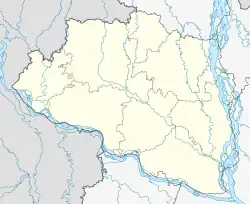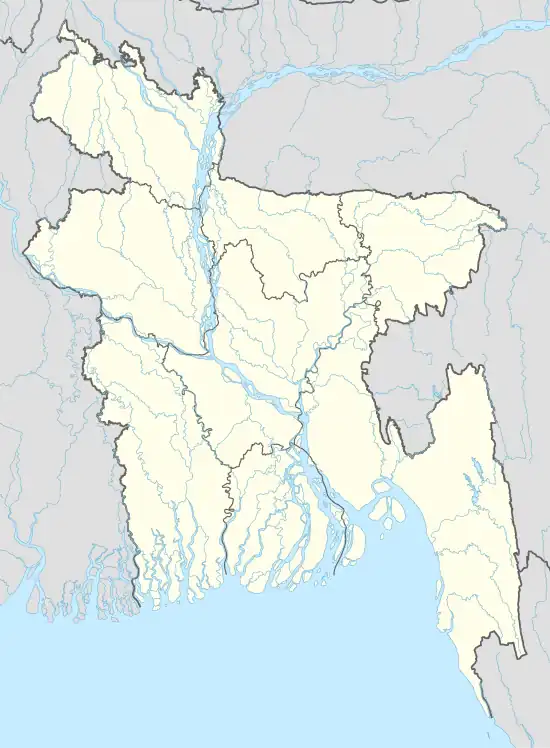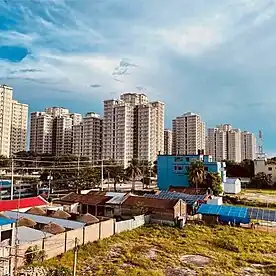Ishwardi Upazila
Ishwardi (Bengali: ঈশ্বরদী, Ish-shordi) is an upazila of Pabna District in Rajshahi Division. It is the westernmost upazila of Pabna district. This upazila is a dynamic administrative region with a rich cultural heritage and significant economic importance. Situated in the fertile Gangetic floodplain, Ishwardi Upazila boasts a landscape shaped by the Ganges and its tributaries. This region is renowned for its agricultural productivity, particularly in the cultivation of rice, vegetables, litchi, sugarcane and other crops. Ishwardi upazila is not only an agricultural hub but also home to various industries, including the Ruppur Nuclear Powerplant and Ishwardi Export Processing Zone, which have contributed to its economic growth. With a harmonious blend of rural and urban areas, this upazila offers a glimpse into the traditional lifestyle and modern developments that coexist within its boundaries.
Ishwardi
ঈশ্বরদী | |
|---|---|
 Ishwardi Location of Ishwardi city in Rajshshi Division  Ishwardi Location in Bangladesh | |
| Coordinates: 24°9′N 89°4′E | |
| Country | |
| Division | Rajshahi Division |
| District | Pabna District |
| Government | |
| • Type | Local government |
| • Body | Upazila Parishad |
| • Upazila Chairman | Md. Nayeb Ali Biswas (Bangladesh Awami League) |
| • Upazila Vice Chairman | Md. Abdus Salam |
| Area | |
| • Total | 246.9 km2 (95.3 sq mi) |
| Elevation | 12.9 m (42.3 ft) |
| Population (2011)Population and Housing Census 2011 | |
| • Total | 313,932 |
| • Density | 1,300/km2 (3,300/sq mi) |
| Time zone | UTC+6 (BST) |
| Postal code | 6620 |
| Website | http://www.ishurdi.pabna.gov.bd |
Etymology
While many theories have been proposed about Ishwardi's etymology, no consensus has emerged.
According to Banglapedia, the name 'Ishwardi' means God's place.[1]
Community Report on Pabna District (2013) says-[2]
Nothing is definitely known about the origin of the upazila name. It is learnt that in the past, Isa khan, the Mughal general with his soldiers arrived at the place where the present upazila headquarters is located. At that time there was scarcity of drinking water and Isa khan dug a big lake (meaning dighi in Bengali) for his soldiers. This lake or dighi was popularly known as Isa dighi. In course of time the area in and around the dighi became known as Ishwardi due to phonetic corruption.
— Bangladesh Bureau of Statistics, Community Report- Pabna District, Population & Housing Census, 2011, page 44

Geography
Geographic location
The upazila occupies an area of 250.89 sq. km. It is located between 24º03′ and 24º15′ north latitudes and between 89º00′ and 89º11′ east longitudes. The upazila is bounded on the north by Baraigram upazila and Lalpur upazila of Natore district, on the east by Atgharia upazila and Pabna Sadar upazila, on the south by Kumarkhali upazila and Mirpur upazila of Kushtia district and on the west by Bheramara upazila of Kushtia district.[2] The river Padma flows beside Ishwardi and detaches this upazila from Kushtia district.
Geomorphology
Ishwardi Upazila exhibits a diverse geomorphology. The region is characterized by a mix of plain, low-lying areas and elevated landforms. The major portion of Ishwardi Upazila lies in the vast Gangetic floodplain, featuring fertile alluvial soil deposited by the rivers. The landscape comprises riverbanks, floodplains, and locally elevated areas. The Ganges (locally known as Padma), one of the major rivers in Bangladesh, flows along the western and south-western boundary of Ishwardi, shaping the geomorphology of the region. The presence of rivers, along with their associated erosional and depositional processes, has played a significant role in shaping the landforms and sedimentary patterns of Ishwardi Upazila.
Climate
According to the kopen climate classification, Ishwardi has a humid subtropical or tropical savanna climate.The weather is influenced by Indian monsoon. Much of the yearly rainfall is received from the south west monsoon. Generally, monsoon hits this region in the 2nd week of June and retreats at the end of October.
A weather observatory was established in Ishwardi in 1963. Since then, the observatory is recording weather data. Its International Station Number is 41907. Highest maximum temperature ever recorded in Ishwardi is 44 °C and lowest minimum temperature ever recorded is 3.5 °C; which were recorded on May 13, 1970 and January 27, 1964 respectively. Highest 24 hour rainfall of 351 mm was recorded on July 11, 1976 in Ishwardi.[3]
| Month | Jan | Feb | Mar | Apr | May | Jun | Jul | Aug | Sep | Oct | Nov | Dec | Year |
|---|---|---|---|---|---|---|---|---|---|---|---|---|---|
| Record high °C (°F) | 31.1 (88.0) |
34.4 (93.9) |
40.6 (105.1) |
42.3 (108.1) |
44.0 (111.2) |
38.7 (101.7) |
35.0 (95.0) |
36.1 (97.0) |
36.7 (98.1) |
37.4 (99.3) |
34.4 (93.9) |
30.6 (87.1) |
44.0 (111.2) |
| Average high °C (°F) | 24.2 (75.6) |
27.7 (81.9) |
32.9 (91.2) |
35.5 (95.9) |
34.7 (94.5) |
33.5 (92.3) |
32.4 (90.3) |
32.5 (90.5) |
32.4 (90.3) |
31.7 (89.1) |
29.5 (85.1) |
26.6 (79.9) |
31.1 (88.1) |
| Daily mean °C (°F) | 16.5 (61.7) |
19.9 (67.8) |
25.0 (77.0) |
28.6 (83.5) |
28.9 (84.0) |
29.0 (84.2) |
28.5 (83.3) |
28.8 (83.8) |
28.3 (82.9) |
26.6 (79.9) |
22.6 (72.7) |
18.2 (64.8) |
25.1 (77.1) |
| Average low °C (°F) | 10.4 (50.7) |
13.3 (55.9) |
18.2 (64.8) |
23.0 (73.4) |
24.4 (75.9) |
25.8 (78.4) |
26.0 (78.8) |
26.2 (79.2) |
25.6 (78.1) |
23.0 (73.4) |
17.5 (63.5) |
12.3 (54.1) |
20.5 (68.9) |
| Record low °C (°F) | 3.5 (38.3) |
6.7 (44.1) |
10.6 (51.1) |
16.7 (62.1) |
14.4 (57.9) |
19.4 (66.9) |
21.1 (70.0) |
21.7 (71.1) |
21.1 (70.0) |
17.2 (63.0) |
11.1 (52.0) |
7.2 (45.0) |
3.5 (38.3) |
| Average precipitation mm (inches) | 6.2 (0.24) |
22.2 (0.87) |
33.3 (1.31) |
77.0 (3.03) |
167.7 (6.60) |
237.5 (9.35) |
298.9 (11.77) |
218.2 (8.59) |
292.7 (11.52) |
110.3 (4.34) |
16.3 (0.64) |
8.4 (0.33) |
1,488.7 (58.59) |
| Average rainy days | 2 | 2 | 3 | 7 | 11 | 12 | 20 | 14 | 13 | 6 | 2 | 1 | 93 |
| Average relative humidity (%) | 76 | 70 | 63 | 66 | 75 | 83 | 86 | 85 | 85 | 82 | 77 | 77 | 77 |
| Source: Bangladesh Meteorological Department[4][5][6] | |||||||||||||
Demographics
As of the 2011 Bangladesh census, Ishwardi has a population of 3,13,932, among whom 66,255 live in the urban areas and 2,47,677 live in the rural areas. The male population is 1,57,897 and female population is 1,56,035. This Upazila has a household of 73,373. Among them, urban household number is 15,332 and rural household number is 58,041. Ishwardi has an average literacy rate of 54.96% (7+ years), which is highest in Pabna district and also higher than the national average of 51.77% literate.[7]
Among the total population of Ishwardi, 305033 confirmed to be Muslim, 8024 confirmed to be Hindu, 507 confirmed to be Christian, 11 confirmed to be Buddhist and 357 did not state in the 2011 Population and Housing census.[8]
Majority of Ishwardi's inhabitants are ethnic Bengali who speak Bangla. Along with them, some Urdu speaking Bihari people also live here.
Administration
Local government
The smallest rural local government unit in Bangladesh is Union council and the next upper level of this is Upazila Parishad. On the other hand, Municipal Corporation is the smallest unit for urban local government.[9] Ishwardi thana was transformed into a upazila (sub-district) in 1982 by a government ordinance.[10] As of 2022, the chairman of Ishwardi Upazila Parishad is Md. Nayeb Ali Biswas. Additionally, the current Vice Chairman is Md. Abdus Salam and Female Vice Chairman is Mst. Atia Ferdous.[11] Ishwardi Upazila has seven Union councils: Dashuria, Luxmikunda, Muladuli, Paksey, Sahapur, Sara, and Solimpur. The union councils are subdivided into 128 mauzas and 126 villages.[12] On the other hand, Ishwardi Municipality is the only municipality in the upazila. It is subdivided into 9 wards and 27 mahallas.[12] The current Mayor is Isaac Ali Malitha.[13]
Executive Department
The current Upazila Nirbahi Officer of Ishwardi Upazila is P.M. Emrul Kayes.[14]
Agriculture
Ishwardi is a vast fertile plain which is suitable for agriculture. Paddy, wheat, sugarcane, betel leaf and vegetables are the main crops of this region.[1] In addition, Litchi orchards are common in Ishwardi's households. This summer fruit is also considered as the 'cash crop' of Ishwardi.[15]
Ishwardi is a hub for agricultural research institutes. The headquarter of Bangladesh Sugarcrop Research Institute (BSRI) is located here. This institute conducts research on crops like sugarcane, palm, date, stevia, sugar beet, nipa palm etc.[16] Many varieties of these crops are developed and released from here.[17] Bangladesh’s only Pulses Research Center (PRC) is also situated here.[18]
Along with these, Ishwardi contains regional research center of Bangladesh Agriculture Research Institute[18] and Bangladesh Institute of Nuclear Agriculture.[19] Moreover, Horticultural Center[20] and Sericulture Development Board[21] conduct their activity here.
Transport
Ishwardi is well connected to the country's major cities by highways, railways and rivers. Lalon Shah Bridge and Hardinge Bridge connects Ishwardi Upazila to the south-western part of Bangladesh by highway and railway respectively. Ishwardi Railway Junction is one of the largest railway junctions in Bangladesh.

A port was also established in on the banks of Padma River to facilitate construction and future operation of Rooppur Nuclear Power Plant. The port became fully operational in 2020.[22][23]

Ishwardi Airport is an airport located in Ishwardi which is currently not functional.[24]
Industry
Ishwardi EPZ
There is an Export Processing Zone in Ishwardi which is known as Ishwardi EPZ. It was established in 2001 on 308.97 acres of land as a special economic zone for producing export-oriented products. Investors from South Korea, India, Japan, China and Hong Kong have invested in Ishwardi EPZ. The EPZ mainly produces footwear & leather goods, wig, tent, industrial gloves, RMG, garment accessories, yarn, plastic goods, chemical & fertilizer, denim products etc.[25]
Rooppur Nuclear Powerplant
Rooppur Nuclear Power Plant is a significant energy project located in Rooppur, Bangladesh. It is the country's first-ever nuclear power plant and a flagship venture in its pursuit of clean and sustainable energy. The power plant is being constructed on the banks of the river Padma, approximately 160 kilometers northwest of the capital city, Dhaka. Once fully operational, it will consist of two VVER-1200 reactors, each with a capacity of 1,200 megawatts. The Rooppur Nuclear Power Plant will play a crucial role in meeting the increasing energy demands of Bangladesh, diversifying its energy mix, and reducing its dependence on fossil fuels, thereby contributing to the nation's economic growth and environmental sustainability.
Pabna Sugar Mills Limited
Pabna Sugar Mills Limited is located in Ishwardi's Dashuria area. It was established in 1992 on 60 acres of land. It mainly used to produce sugar from sugarcane collected from nearby areas. Besides, it produced molasses, press mud and bagasse as by-product.[26] Currently the mill is temporarily not functional and going through modernization processes.[27]
Banarasi Palli
After the partition of India in 1947, many Banarasi craftsmen migrated to Ishwardi from North Indian regions and started living in Ishwardi's Fateh Mohammadpur locality. They started weaving aristocratic sarees like Banarasi and Katan. Many of their descendants have preserved their ancestors' heritage till now.[28] To expand the manufacturing and marketing of Banarasi products, Bangladesh Handloom Board established country's second-largest Banarasi Palli in 2004 at Ishwardi's Fateh Mohammadpur. But the Banarasi Palli was reported not to be fully functional.[29] Many craftsmen are seen producing Banarasi sarees individually. The Banarasi Palli region remains very active during festivals like Eid.[30]
Education
Ishwardi Upazila has a handful of educational institutions. Some of the well-known secondary schools in Ishwardi are Ikkshu Gabeshawana High School, Bangladesh Railway Government Chandraprabha Vidyapitha, Govt. Sara Marwari Model High School[31] and North Bengal Paper Mills High School.[32] Among the higher secondary schools (or colleges, as they are termed in Bangladesh), Ishwardi Govt. College[33] and Ishwardi Women’s College are reputed. In addition, Bangladesh Open University operates their branch in Ishwardi. Besides, a Vocational Training Institute is also situated here.[34] Apart from these, there are some madrasahs in Ishwardi namely Mazdia Babul Ulum Islamia Fazil Madrasah, Ishwardi Alia Madrasah, Autapara A B C Alim Madrasah and so on.
Literary works
Celebrated Indian novelist Amiya Bhushan Majumdar's Bengali novel Garh Shrikhanda is based on the socio-economic condition of the Padma riparian areas of Ishwardi. This novel dates back to the 1940s. It was published in 1957 by Dey's Publishing at Kolkata.[35]
Notable residents
- Shankha Ghosh, Indian poet and literary critic, passed matriculation from Chandraprabha Vidyapitha, Ishwardi.[36]
- Amiya Bhushan Majumdar, celebrated Indian novelist.[37]
- Mozid Mahmud, poet, was born at Char Gargari village in 1966.[38]
- Shamsur Rahman Sherif, MP, ex-minister of Ministry of Land, has been the Member of Parliament for constituency Pabna-4 since 1996.[39]
- Nuruzzaman Biswas - Bangladeshi politician & MP.
References
- Md Shahidullah Khan (2012), "Ishwardi Upazila", in Sirajul Islam and Ahmed A. Jamal (ed.), Banglapedia: National Encyclopedia of Bangladesh (Second ed.), Asiatic Society of Bangladesh
- Bureau of Statistics, Bangladesh (July 2013). "Community Report- Pabna District, Population & Housing Census, 2011" (PDF). bbs.gov.bd. Retrieved 31 December 2022.
- Mossammat Ayesha Khatun; Md. Bazlur Rashid; Hans Olav Hygen (31 May 2016). "Climate of Bangladesh" (PDF). MET Report. Norwegian Meteorological Institute. ISSN 2387-4201. Archived from the original (PDF) on 2018-12-24.
- "Climate of Bangladesh" (PDF). Bangladesh Meteorological Department. pp. 19–23. Archived from the original (PDF) on 24 December 2018. Retrieved 24 December 2018.
- "Normal Monthly Rainy Day" (PDF). Bangladesh Meteorological Department. Archived from the original on 9 July 2017. Retrieved 26 April 2018.
- "Normal Monthly Humidity" (PDF). Bangladesh Meteorological Department. Archived from the original on 24 December 2018. Retrieved 26 April 2018.
- Population and Housing Census 2011 Zila Report: Pabna (1st ed.). Dhaka: Bangladesh Bureau of Statistics. 2015. pp. 49–72. ISBN 978-984-33-8634-2.
- Bureau of Statistics, Bangladesh (July 2013). "Community Report - Pabna District" (PDF). bbs.gov.bd. Retrieved 31 December 2022.
- Bangladesh and Global Studies (3rd ed.). Dhaka: National Curriculum and Textbook Board. 2017. pp. 135–145.
- উপজেলা প্রশাসনের পটভূমি. Ishurdi Upazila (in Bengali). Retrieved 2022-09-27.
- "Leaders". Ishurdi Upazila. Retrieved 2022-09-27.
- "District Statistics 2011: Pabna" (PDF). Bangladesh Bureau of Statistics. Archived from the original (PDF) on 13 November 2014. Retrieved 14 July 2014.
- "Ishwardi (Pabna): Isaac Ali Malitha, Municipal Mayor speaks at a discussion meeting as the Chief Guest on the occasion of the Historic Six-Point Demand Day in Ishwardi Upazila on Tuesday". The New Nation. Retrieved 2022-09-27.
- "List of Upazila Nirbahi Officers". pmis.mopa.gov.bd. Retrieved 2022-09-27.
- Topu, Ahmed Humayun Kabir; Pabna (2013-06-19). "Ishwardi's litchi legacy". The Daily Star. Retrieved 2022-09-27.
- "বাংলাদেশ সুগারক্রপ গবেষণা ইনস্টিটিউট-গণপ্রজাতন্ত্রী বাংলাদেশ সরকার". www.bsri.gov.bd. Retrieved 2022-09-27.
- "কৃষি তথ্য সার্ভিস (এআইএস)". www.ais.gov.bd. Retrieved 2022-09-27.
- "ডাল গবেষণা কেন্দ্র ও আঞ্চলিক কৃষি গবেষণা কেন্দ্র". prc-rars.pabna.gov.bd. Retrieved 2022-09-27.
- "বাংলাদেশ পরমাণু কৃষি গবেষণা ইনস্টিটিউট". www.bina.gov.bd. Retrieved 2022-09-27.
- "হর্টিকালচার সেন্টার, ঈশ্বরদী, পাবনা". hc.ishurdi.pabna.gov.bd. Retrieved 2022-09-27.
- "বাংলাদেশ রেশম উন্নয়ন বোর্ড". www.bsb.gov.bd. Retrieved 2022-09-27.
- "Port of Rooppur NPP gets operational". The Business Standard. 2020-08-29. Retrieved 2023-01-01.
- Staff Correspondent. "Padma port ready to receive large equipment for Rooppur Nuclear Power Plant". bdnews24.com. Retrieved 2023-01-01.
- "Bangladesh seeks Russian investment in Ishwardi Airport". The Business Standard. 2021-08-19. Retrieved 2023-01-01.
- Export Processing Zone Authority, Bangladesh (2021). "Glance Tour on Ishwardi EPZ" (PDF). bepza.gov.bd. Retrieved 31 December 2022.
- Sugar and Food Industries Corporation, Bangladesh (9 February 2020). "Basic Information about Sugar Mill". bsfic.gov.bd (in Bengali). Retrieved 14 September 2023.
- দিগন্ত, Daily Nayadiganta-নয়া. "৪০০ কোটি টাকা লোকসানের বোঝা ১৬ মাস বন্ধ পাবনা সুগার মিল". Daily Nayadiganta (নয়া দিগন্ত) : Most Popular Bangla Newspaper (in Bengali). Retrieved 2023-09-14.
- "দুই কোটির বেনারসি পল্লীতে প্লট আছে তাঁতি নেই". দৈনিক ইত্তেফাক (in Bengali). Retrieved 2023-01-01.
- Bangladesh, Inside (2022-12-14). "Why is Ishwardi Banarasi Palli not fully functional yet?". The Daily Star. Retrieved 2023-01-01.
- "Ishwardi Benarasi Palli gear up for Eid expecting Tk20cr in wholesale". Dhaka Tribune. 2019-05-30. Retrieved 2023-01-01.
- "Govt saramarwari school & college | Education for all". Retrieved 2022-09-27.
- "North Bengal Paper Mills High School". nbpmhs.edu.bd. Retrieved 2022-09-27.
- "EMS". www.igc.edu.bd. Retrieved 2022-09-27.
- "টেক্সটাইল ভোকেশনাল ইনস্টিটিউট, ঈশ্বরদী, পাবনা". tvi.pabna.gov.bd. Retrieved 2022-09-27.
- Majumdar, Amiya Bhushan (1957). Garh Shrikhanda (2nd ed.). Kolkata: Dey's Publishing. pp. 9–10. ISBN 81-7612-941-0.
- কবি শঙ্খ ঘোষ আর নেই. Prothom Alo (in Bengali). Retrieved 2022-09-27.
- দত্ত, আবাহন. "পেশায় ডাকঘরের কর্মী, জাতে লেখক". www.anandabazar.com (in Bengali). Retrieved 2022-09-27.
- পাবনায় ভালোবাসায় সিক্ত হলেন কবি ও গবেষক মজিদ মাহমুদ [Majid Mahmud, a poet and researcher, is woken up in love with Pabna]. Jagonews24.com (in Bengali). 19 April 2015.
- "Pabna-4 nomination seekers woo party stalwarts for tickets". The Financial Express. Dhaka. 20 December 2017.
